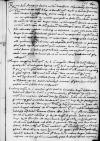Dominus ⌊Michael Zelislawsky⌋, sciens Vestram Dominationem Reverendissimam me amare, petiit a me, ut ipsum Vestrae Dominationi Reverendissimae maiori, quo possem, studio commendarem. Fortassis Vestram Reverendissimam Dominationem a ⌊maiestate regia⌋ sacra in commissarium obtinuit, ut controversiam inter ipsum et dominum ⌊palatinum Marienburgensem⌋ una cum aliis dominis sibi adiunctis audiat videatque et discutiat, in qua iam sacrae ⌊maiestatis regiae⌋ sententiam se habuisse perhibetur, tamen in executione impeditur. ⌊Eundem⌋ itaque Vestrae Reverendissimae Dominationi commendamus et maximopere petimus, velit eius iustitiam, quantum aequum est, relevare, ut aliquando finem habeat, ne potentia plus posse apud vos videatur, quam iustitia. Rem enim valde gratam nobis faciet, si ⌊eidem⌋ prae se tulerit nostram intercessionem apud se valere. Vir profecto bonus est et non meretur istas turbationes, quibus affligitur.
Nuper accepimus litteras Vestrae Reverendissimae Dominationis cum unguento macis ex ⌊Cracovia⌋ allatas, quas quidem cum voluptate legimus, Vestrae Reverendissimae Dominationis ex eisdem statum cognoscentes, et pro unguento gratias habemus, eodem enim dolorem, cum nobis accidit, lenimus Vestraeque Dominationi gratias agimus. Referemus autem aliquando, nam ex voto vestro semper sumus. Ea etiam significatione consolati sumus, quod Vestra Reverendissima Dominatio iam animo conceperit et constituit ope Dei sacris ordinibus se initiari, quod quidem Deus eidem ad profectum animae salutis bene auspicetur.
Credimus Vestram Reverendissimam Dominationem iam scire, quid sit factum de concordia ⌊regum dissidentium⌋. Nobis autem scriptum de ⌊Cracovia⌋ a certis auctoribus, quod discessum est ab invicem nedum sine concordia, sed etiam sine spe concordiae. Interea enim, dum concordia per utriusque partis comissarios tractaretur, serenissimus ⌊rex Romanorum⌋ stratagemate sollerti usus est. Nam apud ⌊Turcum⌋ per dominum ⌊Ieronimum de Zara⌋ obtinuit longas indutias et cum magno amore, quod ipsum in filium adoptaverit indutiisque constitutis ⌊Turcarum caesar⌋ illico ⌊Iohanni regi⌋ scribens mandavit, ut ab omni hostilitate adversus serenissimum ⌊Romanorum regem⌋ se contineret. Itidem et serenissimo ⌊regi Romanorum⌋ commisit, et mandavit suis gentibus in finibus constitutis, ut ab omni hostilitate inferenda se continerent. ⌊Uterque autem rex candidatus⌋ debet mittere ad ⌊Turcum⌋ oratores, ipse enim vult inter eos concordiam constituere et ob eam rem tam ⌊Ieronimum de Zara⌋, quam dominum ⌊Opalensky⌋ apud se retinet. Dicitur autem, quod ⌊rex Romanorum⌋ eidem ⌊regno Sclavoniae⌋ cesserit et his insulis et civitatibus, quas ⌊Andreas Doria⌋ ceperat.
Scribitur etiam, quod ⌊caesarea maiestas⌋ ob mortem ⌊regis Portugaliae⌋ acceleret in ⌊Hispaniam⌋, praesertim quod ⌊rex Galliarum⌋ illic manum ponere decreverit. Soluto itaque congressu cum ⌊summo pontifice⌋ et non facta determinatione de celebrando concilio, ⌊Mediolanum⌋ profectus est et inde ⌊Ianuam⌋ concedit, ubi ⌊Doria⌋ acceptis octoginta milibus florenorum eundem ⌊caesarem⌋ cum classe parata exspectat.
Haec ad nos scripta sunt, quae, hanc nactus occasionem, Vestrae Reverendissimae Dominationi ignota esse nolui. Cuius amori nos commendamus.


